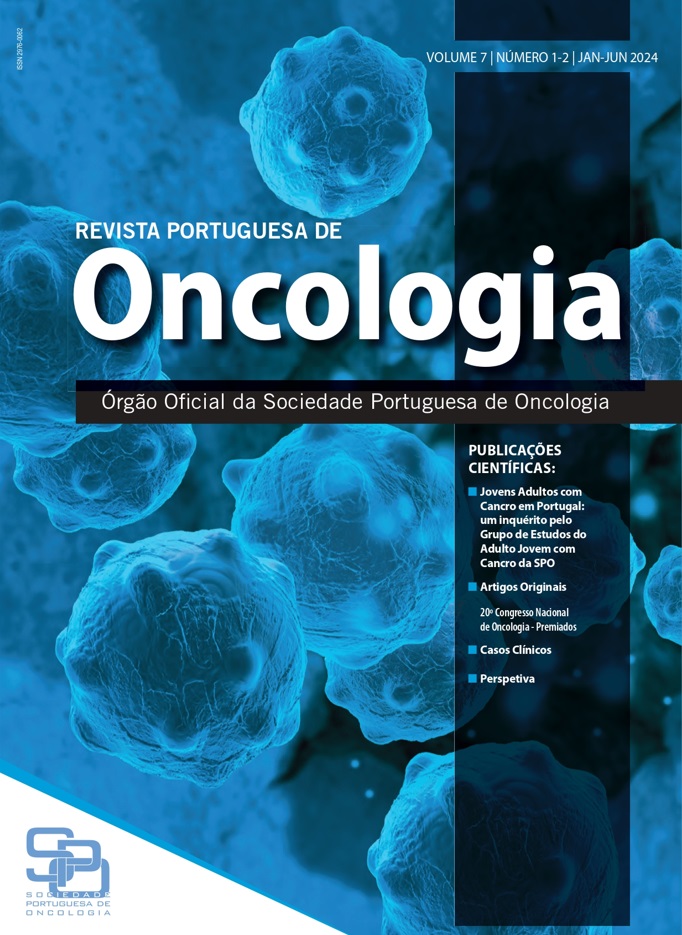Four cases of mesonephric adenocarcinoma of the cervix: a rare histology
Palavras-chave:
Adenocarcinoma mesonéfrico; cancro do cérvix; multidisciplinaridade.Resumo
Introduction: Mesonephric adenocarcinoma of the uterine cervix is a rare tumor, originating from remnants of the mesonephric duct. The differential diagnosis from other cervical carcinoma can be challenging. The existing data in the literature, regarding clinical history, diagnosis, prognosis and treatment is scarce.
Methods: Four patients diagnosed with mesonephric adenocarcinoma of the cervix were treated at our institution. The clinicopathological data of these patients was collected.
Results: The patients presented postmenopausal metrorrhagia at diagnosis. Three patients underwent type C radical hysterectomy and pelvic lymphadenectomy, being staged (FIGO) as pIB1, pIB3 and pIIB, respectively. One patient was under surveillance, one patient underwent adjuvant treatment (radiotherapy and brachytherapy) and the third patient was restaged, stage IV, initiating palliative chemotherapy. One patient, stage IIIC1, underwent radical radiochemotherapy and brachytherapy. The patient presented regional and distant recurrence, and it was decided systemic treatment. Histologically, the tumors presented a mixture of patterns including papillary, glandular with the presence of spindle cells in two patients. The immunohistochemistry showed expression of CAM 5.2, CD10, vimentin, GATA3, calretinin, absence of expression of WT1 and hormone receptors, and p53 wild-type.
Conclusions: The rarity of this disease raises challenges in its management, namely diagnosis, prognosis and therapeutic approach.
Downloads
Referências
Ferry JA, Scully RE: Mesonephric remnants, hyperplasia, and neoplasia in the uterine cervix. A study of 49 cases. Am J Surg Pathol. 1990, 14:1100-11. DOI: 10.1097/00000478-199012000-00002
Houghton O, Jamison J, Wilson R, Carson J, McCluggage. p16 Immunoreactivity in unusual types of cervical adenocarcinoma does not reflect human papillomavirus infection. Histopathology. 2010; 57:342-50. DOI: 10.1111/j.1365-2559.2010.03632.x
Pors J, Segura S, Chiu DS, Almadani N, Ren H, Fix DJ, et al. Clinicopathologic characteristics of mesonephric adenocarcinomas and mesonephric-like adenocarcinomas in the gynecologic tract: a multi-institutional study. Am J Surg Pathol. 2021;45:498-506. 10.1097/PAS.0000000000001612
Dierickx A, Göker M, Braems G, Tummers P, Van den Broecke. Mesonephric adenocarcinoma of the cervix: case report and literature review. Gynecol Oncol Rep. 2016;17:7-11. DOI: 10.1016/j.gore.2016.05.002
Abdul-Ghafar J, Chong Y, Han HD, Cha DS, Eom M. Mesonephric adenocarcinoma of the uterine cervix associated with florid mesonephric hyperplasia: a case report. J Lifestyle Med. 2013;3:117-20.
Ersahin C, Huang M, Potkul RK, Hammadeh R, Salhadar A. Mesonephric adenocarcinoma of the vagina with a 3-year followup. Gynecol Oncol. 2005;99:757-60. 10.1016/j.ygyno.2005.07.010
Reis-de-Carvalho C, Vaz-de-Macedo C, Ortiz S, Colaço A, Calhaz-Jorge. Cervical mesonephric adenocarcinoma: a case report of a rare gynecological tumor from embryological remains of the female genital tract. Rev Bras Ginecol Obstet. 2021;43:329-33. DOI:10.1055/s-0041-1725051
Silver SA, Devouassoux-Shisheboran M, Mezzetti TP, Tavassoli FA. Mesonephric adenocarcinoma of the uterine cervix: a study of 11 cases with immunohistochemical findings. Am J Surg Pathol. 2001;25:379-87. DOI: 10.1097/00000478-200103000-00013
Fukunaga M, Takahashi H, Yasuda M. Mesonephric adenocarcinoma of the uterine cervix: a case report with immunohistochemical and ultrastructural studies. Pathol Res Pract. 2008;204:671-6. DOI:10.1016/j.prp.2008.01.008
Goyal A, Yang B. Differential patterns of PAX8, p16, and ER immunostains in mesonephric lesions and adenocarcinoma of the cervix. Int J Gynecol Pathol. 2014;33:613-9. DOI: 10.1097/PGP.0000000000000102
Jiang L, Tong D, Feng Z, Liu K. Mesonephric adenocarcinoma of the uterine cervix with rare lung metastases: a case report and review of the literature. World J Clin Cases. 2020;6:1735-44. DOI: 10.12998/wjcc.v8.i9.1735










